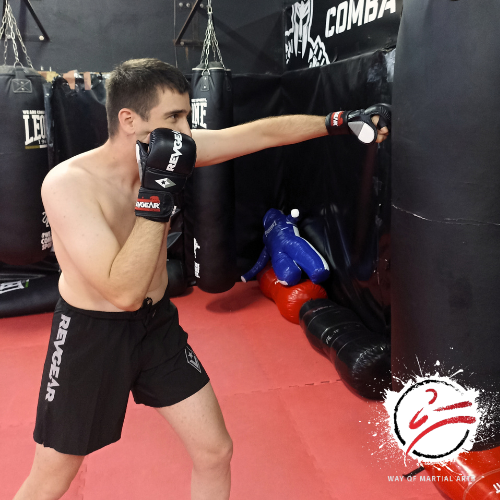Mixed Martial Arts (MMA) is a sport that demands a high level of physical fitness, combining strength, speed, endurance, and agility. To excel in MMA, fighters must engage in a rigorous training regimen that includes both strength training and metabolic conditioning.
This article provides a comprehensive guide to the best exercises for MMA fighters, drawing insights from two key sources: Torokhtiy’s blog on weight training for MMA and Onnit Academy’s article on metabolic conditioning workouts.
The Importance of Weight Training For An MMA Fighter
Weight training is not just a supplement to an MMA fighter’s regimen; it’s a cornerstone. Each exercise targets specific muscle groups and offers unique benefits that translate directly into improved performance in the octagon.
Deadlifts:
- Target Muscles: Primarily works the posterior chain, including the glutes, hamstrings, and lower back. It is also one of the best strength training exercises.
- Benefits for MMA: Deadlifts develop the foundational strength needed for powerful leg drives, essential for executing explosive takedowns and maintaining a strong base in grappling exchanges. The exercise also enhances grip strength, crucial for effective grappling.
Squats:
- Target Muscles: Focuses on the quadriceps, hamstrings, glutes, and core.
- Benefits for MMA: Squats are integral for lower body strength, vital for generating force during takedowns and maintaining stability during stand-up exchanges. The exercise also improves jump height, which is beneficial for knee strikes and overall agility. It starts with a standing starting position, with feet shoulder width apart. However, there are quite a few variations of the squat that can be used to target different parts of the legs.
Pull-Ups:
- Target Muscles: Works the latissimus dorsi, biceps, trapezius, and forearms.
- Benefits for MMA: Pull-ups are key for developing upper body and grip strength, enhancing a fighter’s ability in the clinch, improving control during grappling, and increasing the power behind each strike.
Bench Press:
- Target Muscles: Primarily targets the pectorals, triceps, and deltoids.
- Benefits for MMA: The bench press builds the pushing strength necessary for powerful strikes, particularly punches and pushes during clinch work. It also contributes to overall upper body strength, which is essential in both striking and grappling.
Power Cleans:
- Target Muscles: Engages the entire body, focusing on the hips, legs, and shoulders.
- Benefits for MMA: This explosive lift enhances overall athleticism by improving fast-twitch muscle fiber activation. It’s crucial for developing the explosive power needed for quick, dynamic movements like shooting for takedowns or delivering powerful strikes.
Landmine Jerks and Rotations:
- Target Muscles: Works the shoulders, arms, and core, with a focus on rotational strength.
- Benefits for MMA: These exercises improve functional strength by mimicking the rotational movements common in MMA. They enhance a fighter’s ability to generate power from the core, crucial for striking and defensive movements.
Kettlebell Swings:
- Target Muscles: Primarily targets the glutes, hamstrings, and lower back, along with the shoulders and arms.
- Benefits for MMA: Kettlebell swings develop hip explosiveness, which is vital for powerful kicks, knee strikes, and explosive takedown attempts. The dynamic nature of the swing also improves cardiovascular endurance, a key component in sustaining effort throughout a fight.
Turkish Get-Ups:
- Target Muscles: This is a full-body exercise, engaging the core, shoulders, hips, and stabilizing muscles.
- Benefits for MMA: Turkish Get-Ups are excellent for building functional strength and stability. They improve a fighter’s ability to move efficiently on the ground, transition between positions, and maintain balance and control, which are essential skills in grappling and ground fighting. Not to mention it is one of the best, core strengthening exercises.

Metabolic Conditioning for MMA Fighters
Metabolic conditioning workouts are essential for MMA fighters, focusing on enhancing cardiovascular capacity (VO2 max), muscular strength, power, agility, and promoting lean muscle development while burning fat. Open part of a circuit training routine, they target fast twitch muscle fibers to enhance full body strength and durability.
These workouts are comprehensive, involving the entire body with minimal rest, pushing athletes to their physical limits. Let’s delve deeper into each component:
Kettlebell or Compound Strength Movement:
- Examples: Kettlebell swings, deadlifts, clean and press.
- Benefits: These movements engage multiple muscle groups simultaneously, improving overall strength and power. For MMA fighters, this translates to more effective strikes, stronger takedowns, and enhanced endurance during grappling.
Abs/Core Exercises:
- Examples: Planks, Russian twists, hanging leg raises.
- Benefits: Core strength is vital part of MMA workouts and are performed by every professional MMA fighter. It aids in maintaining balance and stability during striking and grappling. A strong core also helps in transferring power from the lower to the upper body, crucial for effective striking and defensive maneuvers.
Lunge/Squat Variations:
- Examples: Walking lunges, jump squats, pistol squats.
- Benefits: These exercises target the quadriceps, hamstrings, and glutes, building lower body strength and power. This is essential for MMA fighters in executing powerful kicks, maintaining a strong base, and enhancing mobility and agility in the octagon. It is also a great MMA strength training exercise.
Push/Pull Exercises:
- Examples: Push-ups, pull-ups, rows, and bench presses.
- Benefits: Push and pull movements develop upper body strength, crucial for punches, clinch work, and grappling. They also enhance shoulder stability and endurance, reducing the risk of injuries during intense bouts.
Press Movements:
- Examples: Overhead press, kettlebell snatch, medicine ball throws.
- Benefits: Press movements improve overall power and shoulder endurance, essential for striking and grappling. They also contribute to upper body explosiveness, beneficial for quick, powerful strikes and defensive actions.
Sample Metabolic Conditioning Workouts
- MMA Metabolic Conditioning Workout: Includes side-to-side kettlebell swings, alternating single-leg burpees, plyo push-up burpees, and dumbbell punches.
- MetCon for Strength and Conditioning: Features heavy kettlebell high pull swings, burpee sprawls, and dumbbell side to side lunges.
- Metabolic Monster: Comprises dumbbell deadlift curls, slalom burpees, and abs V-ups.
- MetCon for BJJ and Grapplers: Involves DB clean and press, rotating burpees, and goblet lunges.
- Muay Thai/Kickboxing Metabolic Conditioning: Consists of alternating DB swings, mountain climber burpees, and med ball Thai power thrust burpees.
Key Factors in MMA Fighters’ Strength Training Routine
Specificity:
- Explanation: This principle involves tailoring the training program to mimic the specific physical and technical demands of MMA. It ensures that the exercises chosen directly enhance the fighter’s performance in the ring.
- Benefits for MMA Fighters: By focusing on movements and muscles used in MMA, fighters can improve their efficiency in executing techniques like strikes, takedowns, and submissions. Specificity in training helps in developing the exact type of strength, endurance, and agility required for MMA, making the training more relevant and effective.
Progressive Overload:
- Explanation: Progressive overload is about gradually increasing the intensity of workouts, either by adding more weight, increasing repetitions, or enhancing the complexity of exercises.
- Benefits for MMA Fighters: This approach helps in continuously challenging the muscles, leading to consistent strength and endurance improvements. It prevents plateaus in training and ensures continuous adaptation and growth, which is crucial for fighters who need to constantly evolve their physical capabilities.
Compound Exercises:
- Explanation: Compound exercises are multi-joint movements that work several muscle groups at the same time. Examples include squats, deadlifts, and bench presses.
- Benefits for MMA Fighters: These exercises are highly efficient for building functional strength and power, as they mimic the complex, multi-muscle movements of MMA. They also improve intermuscular coordination, which is vital for executing complex fighting techniques and combinations.
Recovery:
- Explanation: Recovery involves rest and recuperation processes that allow muscles to repair and grow stronger after intense workouts. This includes adequate sleep, nutrition, hydration, and active recovery techniques like stretching or foam rolling.
- Benefits for MMA Fighters: Proper recovery prevents overtraining, reduces the risk of injury, and ensures that fighters return to training sessions fully rejuvenated. It’s essential for long-term athletic development and peak performance on fight day.
Consistency:
- Explanation: Consistency refers to maintaining a regular and disciplined training schedule over time. It’s about sticking to the training regimen and avoiding long breaks or irregular training patterns.
- Benefits for MMA Fighters: Consistent training leads to steady improvement in strength, endurance, and skill. It helps in building a solid foundation upon which advanced fighting techniques can be developed. Consistency also fosters mental toughness and discipline, traits that are invaluable in the high-pressure environment of MMA.
Conclusion
Strength training and metabolic conditioning are essential components of an all rounded MMA fighter’s MMA training regimen. By incorporating a variety of exercises targeting different muscle groups and focusing on both strength and endurance, MMA fighters can significantly enhance their performance in the octagon.
A well-rounded approach that includes weightlifting, metabolic conditioning, and proper recovery is key to achieving optimal results in the octagon. Whether you are a practitioner of Brazilian jiu jitsu or muray thai, these exercises will ensure that you are ready for anything.
